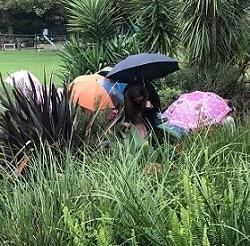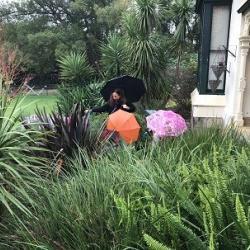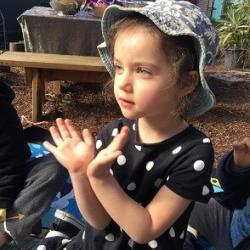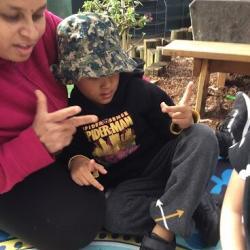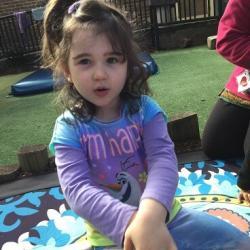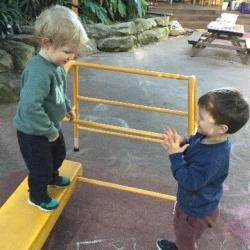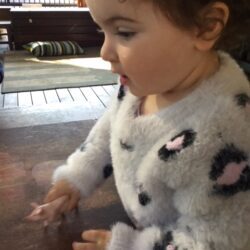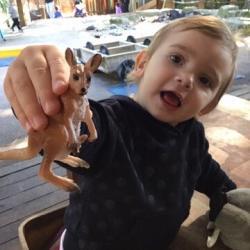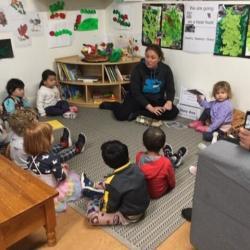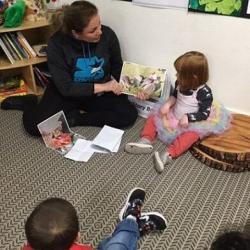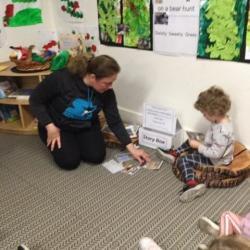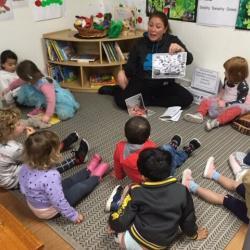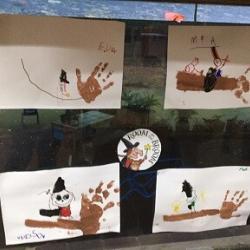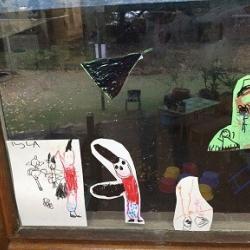Gorton House
On a rainy day this week some of the children from Gorton House preschool grabbed their umbrellas and headed off with educator Nicky to visit the new native bee hive in our gardens.
Two years ago the children in Gorton House preschool began exploring bees, and their significance to the environment and sustainability. They discovered that bees were reducing in number, and they set up a ‘bee hotel’ to attract and shelter native solitary bees in the centre. At this time, our Children’s Services Manager Mariam had also been speaking with staff from Ashbury Public School, who happened to be holding a training workshop on keeping native bees and bee hives. Mariam and Nicky attended the workshop, and they went on a waiting list to receive a native bee hive for The Infants’ Home. This hive finally arrived a couple of weeks ago, and this week the children decided to visit it to see how our new residents are going.
We have also discovered that we have our very own natural native beehive located in a tree within the big garden patch between the reception building and old Gorton Houses, and the children often climb into that space to check on and watch the bees.
Johnson House
In Johnson House the children have been learning sign language, and discussing Auslan (Australian Sign Language) and why it is used. Learning to sign can improve memory, engage children in a new challenge and enhance their literacy development. Learning to sign is particularly beneficial for children who are visual learners. The children are also learning about different communication methods and why these are used, as they learn a new visual language.
The children have been learning the Auslan signs for some of the words in the rhyme ‘5 Cheeky Monkeys’: ‘little’, ‘monkeys’, ‘jumping’, ‘bed’, ‘fell off’, ‘head’, ‘mother’, ‘called’, ‘doctor’, ‘said’ and ‘no’. The children remembered some of these signs from other songs and rhymes they have learned. The children also sang and signed some of the songs they already know, including ‘Hey Diddle Diddle’ and ‘Old MacDonald had a Farm’.
There are many benefits from learning to sign, which include:
- Increased memory retention and motion processing
- Development of neural pathways and cognitive processes unique to using a visual language
- Improved capacity for visual-gestural communication
- Intellectual interest, engagement and personal challenge
- Enhanced development of literacy capabilities.
The children in Johnson House have really embraced this new visual language and have shown curiosity and interest in learning it. The children and educators look forward to learning many more signs as the weeks go on.
Murray House
Infants
The children in Murray House infants love getting involved in play and learning about animals. To help them explore further, their educators have been working on extending the children’s interest by providing a range of learning experiences. This week the children sang ‘Old MacDonald had a Farm’ during music and movement time. They love this song so much that they have been observed singing and humming it even during mealtimes!
Reading books about different animals is another favourite learning experience for the children. ‘Where’s Spot?’ is a famous lift the flap book, written by Eric Hill, and has been the children’s most loved books as they lift the flaps to find Spot the puppy. The children enjoy talking about the different animals they find under the flaps as they search for Spot.
The table with animal figurines on it is a favourite play corner in the infants’ room, and the children love making the sounds of the animal that they recognise, and some of the children have begun role-playing using the animal figures.
Singing, visualising images and playing with props are vital for promoting and enriching literacy learning experiences for children. The educators in Murray House will continue to extend the children’s learning and interests.
Toddlers
In Murray House toddlers the children’s newly emerged interest in counting was extended throughout the week through many intentionally planned experiences, including doing number puzzles, sharing counting books, singing counting songs and rhymes, and playing counting games such as ‘Five Currant Buns’ and ‘Here is a Beehive’. The children particularly enjoy the ‘Five Currant Buns’ game as they like to pretend to pay money and to buy a currant bun by taking a friend’s hand. As the children helped to count each friend as a ‘currant bun’, they were developing their one to one correspondence counting skills. One to one correspondence counting is the ability to touch each object and say the numeral name aloud, as opposed to rote counting which is the act of just saying the numeral names in order: “one, two, three, four, five…”
Small language groups were also offered to the children regularly throughout the day this week. The children are continuing to show strong interest in the story ‘We’re Going on a Bear Hunt’ by Michael Rosen, and they particularly enjoy engaging in an imaginary bear hunt in the playground after reading the story. This week educators also incorporated social and emotional aspects into the language groups with ‘The Feelings’ series of books by Trace Moroney. The educators and children explored how to be kind to others and to themselves, with the intention of fostering children’s emotional resilience, regulation skills and the ability to see others’ perspectives.
Rigby House
Sharing News
The children in Rigby House enjoy telling stories to their friends and educators. Through these stories the children display their wonderful imaginations, and their developing language and social skills.
To support this interest their educators have introduced the ‘Story Box’. Families support their children to place photographs in the box, and then at group time the children share their news using the photos.
This lovely experience helps the children to develop confidence and the ability to focus and concentrate, as well as important communication and social skills. Speaking and listening skills are also developed, as the children are supported by educators to use descriptive words and more complex sentences to share their stories and to ask and answer questions.
The children all agree that sharing stories is a lot of fun!
Robinson House
Recently the children in Robinson House have been learning a fun song called ‘I’m a Witch-Ch-Ch’. The children are always very enthusiastic about singing this song, and joining in with doing the actions. To follow up the children’s interest and to link the song to a picture book, educator Cathy introduced the story ‘Room on the Broom’ to the children. Some of the children were already familiar with this book as they have shared it at home with their family. All of the children were excited to discover how many animals could fit onto the broom and to also pretend to make the noise of the ‘loud dragon’. As the children were sharing the story together, they spoke with Cathy about the themes of the book—helping your friends, making friends and being kind. Julia Donaldson, the author of ‘Room on the Broom’, has created a wonderful story for children to use their imaginations and to take them on a fun adventure. As the children engaged in the experience, they were continuing to facilitate the development of their creative expression and their oral communication skills, and to hear some vocabulary they may not be have been familiar with. The story text is repetitive which supported the children to recall the story as they read it along with Cathy.
